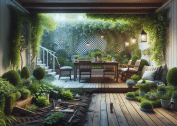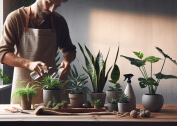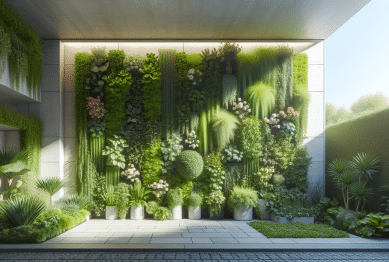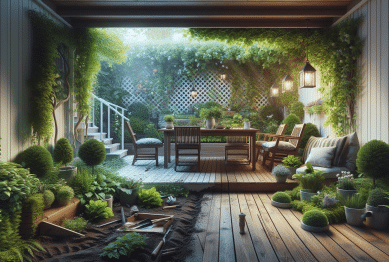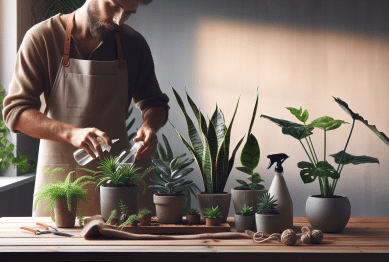Discover how to bring life and character into your home with indoor plants, even if space is limited. This guide explores plant care, creative setups, and practical tips for thriving green corners. Learn how simple changes can boost wellness, add beauty, and personalize any indoor space.
The Power of Indoor Plants in Modern Living Spaces
Every corner of your home has the potential to become vibrant and inviting with well-chosen indoor plants. Even the smallest apartment can benefit from touches of greenery, which not only enhance the aesthetic but also improve air quality and overall well-being. Research suggests that houseplants act as natural air purifiers, helping to remove toxins and increase humidity, creating a fresher environment. Many city dwellers now turn to indoor gardening as a way to connect with nature without needing a yard or large patio. This shift in home trends is supported by advances in plant care resources and growing community support for indoor plant enthusiasts.https://www.epa.gov/indoor-air-quality-iaq/indoor-air-quality-building-occupant-health
Embracing houseplants also supports mental health and relaxation. Plants influence mood, with certain species known to reduce stress and create a calming feel in living rooms, offices, and bedrooms. The presence of greenery has even been linked to greater productivity in work-from-home setups. Small-space dwellers often appreciate the flexibility offered by a selection of potted plants, hanging baskets, and vertical gardens—making it possible to introduce greenery without cluttering tight spaces. The act of caring for plants itself can be meditative, helping establish mindful daily routines that benefit both plant and owner.
Choosing the right plant variety for each room is essential. Those new to indoor gardening may start with hardy options like snake plants, pothos, or peace lilies, which thrive in a variety of lighting conditions and require minimal care. As confidence and interest grow, more delicate species can be introduced to diversify the indoor jungle. Matching plants to the available light, humidity, and temperature ensures long-term success, transforming a plain corner into a lively sanctuary. This adaptability makes indoor plants a favorite option for renters, apartment dwellers, and homeowners alike.
Choosing Plants That Thrive in Small Spaces
Space limitations shouldn’t restrict your indoor garden ambitions. Many compact, low-maintenance plant species flourish in small apartments or rooms with limited natural light. Succulents, air plants, and small ferns are perfect for shelves and windowsills, often requiring only occasional watering and bright, indirect sunlight. These resilient varieties add texture and visual interest without dominating your living area. Research confirms that even a single plant can help refresh the ambiance of a confined space, encouraging more creativity and relaxation.https://hgic.clemson.edu/factsheet/gardening-in-small-spaces/
Vertical gardening is a space-saving strategy growing in popularity. Using wall-mounted planters, hanging pots, or modular vertical systems, you can turn bare walls into dynamic green displays. This method maximizes space efficiency and brings a lush look to your home. Tall, narrow plants like snake plants or ZZ plants work well in corners, while vining plants such as pothos or philodendron trail elegantly from shelves and baskets. Selecting the right containers—lightweight, drainage-friendly ones—further ensures plant health and easy rearrangement as needed.
Consider the light and humidity levels in each part of your home before arranging indoor plants. Bathrooms often suit moisture-loving species like ferns or spider plants, while sun-soaked kitchens encourage thriving herbs or small citrus trees. Small-space dwellers frequently opt for multipurpose planters or modular pots that fit windowsills and ledges, enabling flexible layouts. This adaptability helps you craft visually appealing, personalized gardens no matter how much (or how little) room you have to work with.
Creative Display Ideas for Limited Space
Turn storage challenges into style statements by reimagining traditional plant displays. Multi-level stands, wall shelves, and hanging baskets allow for the creative layering of greenery, making a small room appear fuller and more dynamic. Mixing various heights and textures draws the eye upward, creating the illusion of a larger space. Basics like mason jars, repurposed teacups, or compact terrariums also make charming homes for tiny succulents and cacti, perfect for even the smallest tables or windowsills.https://extension.psu.edu/indoor-plants-for-every-space
Window ledges and unused corners are often overlooked in compact homes. A simple floating shelf placed above a kitchen sink or living room radiator can accommodate several small pots, while a hook in the ceiling holds a trailing ivy or spider plant. Experimenting with geometric planters, stackable cubes, or magnetic plant holders introduces modern, eye-catching elements that double as conversation starters. Combining plant varieties with different leaf shapes and shades gives any display a lush, inviting feel.
For those who love DIY projects, custom plant arrangements offer endless possibilities, from upcycled plant pockets made of fabric to modular vertical gardens built from wooden crates. Even limited outdoor balconies or fire escapes can be transformed with rail planters or mini-greenhouses. The key is to personalize your approach and choose plant groupings that suit both your taste and daily care routine. This empowers you to enjoy greenery, no matter how tight your quarters—making home feel refreshing and truly yours.
Watering, Light, and Care for Healthy Plants
Caring for indoor plants is straightforward when routines are tailored to the needs of each species. While some houseplants prefer letting their soil dry out completely between waterings, tropical varieties require consistent moisture and more frequent misting. Understanding the specific requirements for each plant is crucial for keeping them robust and green. Many homeowners now rely on self-watering pots, digital moisture meters, and easy-reference plant care apps for reminders and guidance, minimizing guesswork.https://www.rhs.org.uk/advice/profile?pid=111
Lighting is another key factor in achieving a flourishing indoor garden. While south-facing windows generally provide the most sunlight, east- or west-facing rooms offer plenty of options for shade-loving plants. Artificial grow lights have become affordable and accessible, ensuring plants can thrive in windowless rooms or during the shorter winter months. These simple solutions make it easier than ever to maintain healthy plants in everyday settings, regardless of the season or floorplan limitations.
Humidity and nutrition also contribute to strong plant growth. Grouping plants together increases humidity around their foliage, mimicking natural environments and supporting tropical species. Routine pruning, fertilizing, and occasional repotting prevent stagnation and spur new growth. Even beginners can master plant health basics with online tutorials, local botanical garden classes, and resources from nonprofit gardening organizations. Ongoing learning helps every plant parent avoid common mistakes and celebrate thriving green companions year-round.
Benefits Beyond Beauty: Wellness and Air Quality
Indoor plants provide more than just lush scenery—they actively contribute to a healthier living space. Studies from respected academic sources show that certain houseplants reduce airborne pollutants like benzene and formaldehyde, supporting better respiratory health indoors. These effects can be particularly noticeable in urban environments where outdoor air quality may fluctuate. Peace lilies, snake plants, and bamboo palm species are especially effective air purifiers, making them attractive choices for bedrooms and workspaces.https://www.ncbi.nlm.nih.gov/pmc/articles/PMC4056005/
The act of nurturing indoor plants has psychological benefits. Gardening, whether on a small or large scale, can enhance mood, reduce symptoms of anxiety, and foster a sense of accomplishment. Indoor greenery introduces biophilic elements—connections to nature that are vital for well-being—without requiring daily outdoor activity. This connection is powerful, especially for people spending significant time indoors or working from home. Even small acts of watering or repotting provide stress relief and gentle routine amid busy schedules.
Adding live plants also promotes mindfulness and intentional living. Observing a plant’s growth, noticing subtle changes in leaves or flowers, and making small environmental adjustments encourage a mindful, attuned approach to home life. Some workplaces now feature indoor gardens or desktop planters to support employee mental health and focus. These wellness benefits, alongside the aesthetic perks, highlight why so many people are embracing houseplants as essentials for home and personal care.
Designing a Personalized Indoor Plant Haven
Personalizing your indoor garden begins with a clear vision for style and function. Some prefer minimalist arrangements—a few sculptural plants paired with neutral pots—while others seek out a dense, jungle-like effect using layered planters and trailing vines. Colors, textures, and container designs all contribute to your unique ambiance. A thoughtfully arranged plant nook can serve as a reading retreat, meditation spot, or vibrant backdrop for creative pursuits.https://www.almanac.com/content/houseplant-care-guide
Incorporate meaningful accessories to further customize your plant displays. Decorative pebbles, driftwood, or handmade plant markers showcase personality and make the process even more enjoyable. DIY macramé hangers or vintage plant stands express creativity and introduce visual contrast. For those with a passion for sustainability, repurposed containers—like glass jars, tin cans, or reclaimed wood—add character while reducing environmental impact. Every decision shapes a living mosaic that is entirely your own.
Keeping a plant care journal amplifies the joy of indoor gardening. Tracking watering schedules, sunlight changes, and bloom cycles sharpens observation skills and deepens your connection with your plants. Sharing cuttings or swapping plants with friends creates community, fostering continuous learning and excitement. The outcome is always personal—an evolving reflection of your tastes, routines, and environment—making indoor plants a rewarding extension of daily life.
References
1. United States Environmental Protection Agency. (n.d.). Indoor Air Quality and Building Occupant Health. Retrieved from https://www.epa.gov/indoor-air-quality-iaq/indoor-air-quality-building-occupant-health
2. Clemson Cooperative Extension. (n.d.). Gardening in Small Spaces. Retrieved from https://hgic.clemson.edu/factsheet/gardening-in-small-spaces/
3. PennState Extension. (n.d.). Indoor Plants for Every Space. Retrieved from https://extension.psu.edu/indoor-plants-for-every-space
4. Royal Horticultural Society. (n.d.). Houseplants: caring for indoor plants. Retrieved from https://www.rhs.org.uk/advice/profile?pid=111
5. Wood, R. A., et al. (2002). Plants and Indoor Environmental Quality. Environmental Health Perspectives. Retrieved from https://www.ncbi.nlm.nih.gov/pmc/articles/PMC4056005/
6. The Old Farmer’s Almanac. (n.d.). Houseplant Care Guide. Retrieved from https://www.almanac.com/content/houseplant-care-guide



